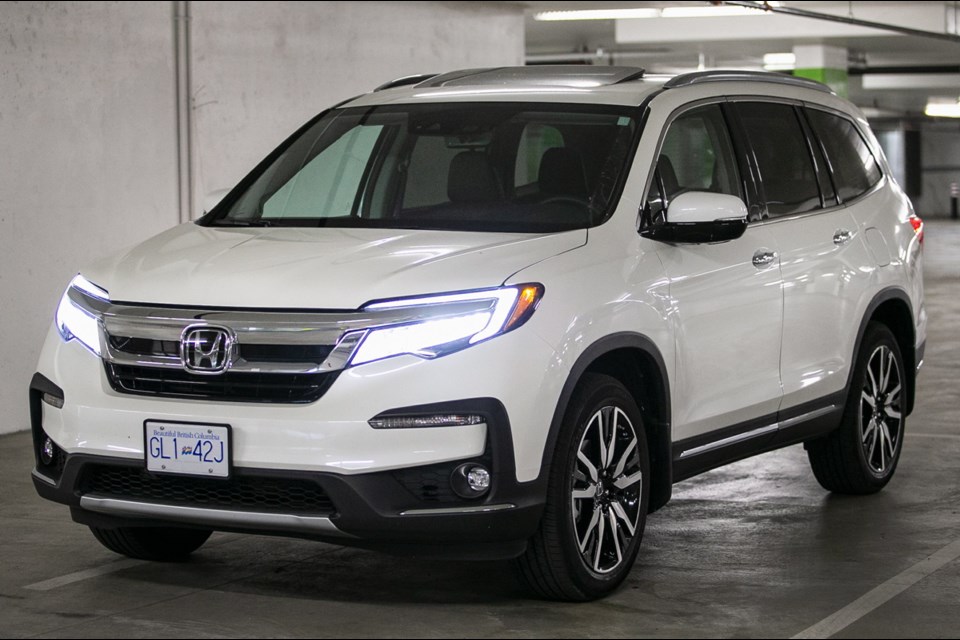A mid-cycle refresh to the 2019 Honda Pilot provides the manufacturer an opportunity to give the mid-sized SUV a host of changes, inside and out.
Mid-cycle for Honda usually means at the two-year mark (as their vehicles typically have a four-year cycle).
Due to the cost, many manufacturers try to stretch it out longer, but not Honda. The obvious advantage to having more frequent updates is obvious — people like to know the vehicle they buy has all the technological improvements in regard to safety, economy and (increasingly) electronic integration.
The three-row Honda Pilot comes in six trim levels with seven- or eight-passenger seating. It starts at $41,290 for an LX. I drove a Touring model, with a list price of $52,690.
A new grille and rear are the most visible changes to the 2019 vehicle. While the older design looked attractive enough in my eyes, some criticized it as too similar to the Honda Odyssey, the company’s minivan.
Nothing causes a manufacturer to cringe more than people saying their vehicle looks like a minivan these days — even if it isn’t true.
The new visage is meant to be more tough-looking, all the way to painting pieces of plastic trim at the bottom of the front and rear bumper silver. Why? Because it looks as if the vehicle possesses a steel skid plate — a desirable piece of equipment for the off-road crowd.
Don’t blame Honda too much — they’re not the first manufacturer to use visual sleight of hand to sell vehicles.
Under the hood, the engine remains the same — a 3.5-litre V-6 producing 280 horsepower and 262 pound-feet of torque. Power runs through a nine-speed automatic transmission to an all-wheel-drive system (lesser models get a six-speed auto).
Honda says it has addressed customer concerns about the performance of the transmission. It reworked the unit mechanically as well as electronically to make it smoother.
It says it has also tweaked the engine stop/start system, reducing the delay in restarting once a person lifts their foot off the brake.
They left the V-6 engine unchanged — which is good, as it is a good match for the mid-sized SUV. It gives ample power even when fully loaded, and can tow 1,588 kilograms (up to 2,268 kg with an accessory towing package).
If fuel economy is on top of your of mind, you will want to engage the green Econ button to the left of the steering wheel.
When engaged, the Pilot will optimizes throttle response, transmission, cruise control and air conditioning settings for maximum economy. Not the best for merging on the highway or travelling up the Coquihalla, but otherwise a wise idea to leave the vehicle in.
The engine also boasts a variable cylinder management system, which deactivates a bank of cylinders under certain driving conditions.
Fuel economy is rated at 12.4 litres per 100 km in the city and 9.3 on the highway.
The Pilot is equipped with Honda Sensing, a suite of safety equipment. My tester was equipped with forward collision warning, collision-mitigation braking, lane-departure warning, lane-keep assist, road-departure mitigation, adaptive cruise control, blind-spot information and rear-cross-traffic alert.
All but the last two features are standard on all Pilots. The last two are available only on the Touring and Black Edition models.
The cabin has also undergone some changes and additions. As much as it desires to distance itself from its minivan brethren, it has nevertheless adopted CabinTalk, a feature that allows the front-row occupants to address (scold, threaten, plead) second-row occupants as with an intercom. The feature mutes music and even pauses videos being played so that you can get heard.
Most rear passengers will certainly appreciate the in-flight entertainment equipment as well — a 10.2-inch screen from the roof, wireless headphones, Blu-ray player, a remote and embedded streaming media apps.
If they prefer their phones or iPads instead, there are power outlets, as well.
Manual side screens reduce light pollution and enhance the experience.
The front of the cabin has undergone a few changes, the most notable being the change of the volume control from a slider to a regular knob — hallelujah. There is also wireless charging for your cell phone.
The Touring model can be ordered with seven- or eight-passenger seating. My tester had the latter, which features sliding and reclining captain’s chairs. The third row can be accessed easily but, like most three-row SUVs, adults will sit with their knees around their ears. Small children, on the other hand, will find it spacious.
The Touring trim now gives you hands-free rear tailgate operation.
The 2019 Honda Pilot isn’t all-new, but improved in almost every department.
THE SPEC SHEET
Type: Mid-sized, three-row SUV, front engine, all-wheel-drive
Engine: 3.5-litre V-6, 280 hp at 6,000 rpm, 262 lb.-ft. of torque at 4,700 rpm
Transmission: Nine-speed automatic
Dimensions (mm): Length, 4,991; width, 2,029; height, 1,794; wheelbase, 2,820
Curb weight (kg): 1,968
Price (base/as tested): $52,690/ $54,710 (includes $1,920 freight and PDI and $100 AC tax)
Options: Nil
Tires: 245/50 R 20 on alloy wheels
Fuel type: Regular
Fuel economy (L/100km): 12.4 city/ 9.3 highway
Warranty: Three years/60,000 km new car, five years/100,000 km powertrain and roadside assistance



